Mario Giulianelli
Shammie
Structure-Conditional Minimum Bayes Risk Decoding
Oct 23, 2025Abstract:Minimum Bayes Risk (MBR) decoding has seen renewed interest as an alternative to traditional generation strategies. While MBR has proven effective in machine translation, where the variability of a language model's outcome space is naturally constrained, it may face challenges in more open-ended tasks such as dialogue or instruction-following. We hypothesise that in such settings, applying MBR with standard similarity-based utility functions may result in selecting responses that are broadly representative of the model's distribution, yet sub-optimal with respect to any particular grouping of generations that share an underlying latent structure. In this work, we introduce three lightweight adaptations to the utility function, designed to make MBR more sensitive to structural variability in the outcome space. To test our hypothesis, we curate a dataset capturing three representative types of latent structure: dialogue act, emotion, and response structure (e.g., a sentence, a paragraph, or a list). We further propose two metrics to evaluate the structural optimality of MBR. Our analysis demonstrates that common similarity-based utility functions fall short by these metrics. In contrast, our proposed adaptations considerably improve structural optimality. Finally, we evaluate our approaches on real-world instruction-following benchmarks, AlpacaEval and MT-Bench, and show that increased structural sensitivity improves generation quality by up to 13.7 percentage points in win rate.
Establishing Best Practices for Building Rigorous Agentic Benchmarks
Jul 03, 2025
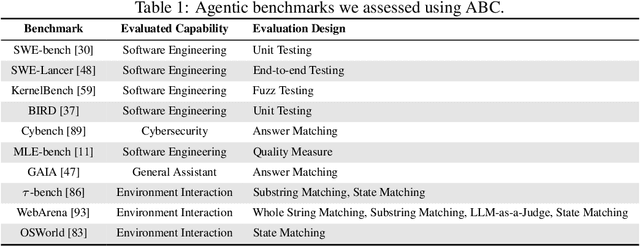

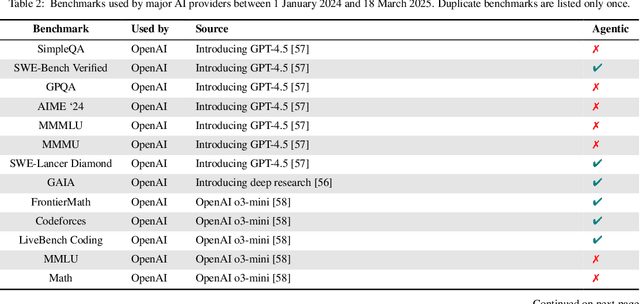
Abstract:Benchmarks are essential for quantitatively tracking progress in AI. As AI agents become increasingly capable, researchers and practitioners have introduced agentic benchmarks to evaluate agents on complex, real-world tasks. These benchmarks typically measure agent capabilities by evaluating task outcomes via specific reward designs. However, we show that many agentic benchmarks have issues task setup or reward design. For example, SWE-bench Verified uses insufficient test cases, while TAU-bench counts empty responses as successful. Such issues can lead to under- or overestimation agents' performance by up to 100% in relative terms. To make agentic evaluation rigorous, we introduce the Agentic Benchmark Checklist (ABC), a set of guidelines that we synthesized from our benchmark-building experience, a survey of best practices, and previously reported issues. When applied to CVE-Bench, a benchmark with a particularly complex evaluation design, ABC reduces the performance overestimation by 33%.
Language Models over Canonical Byte-Pair Encodings
Jun 09, 2025Abstract:Modern language models represent probability distributions over character strings as distributions over (shorter) token strings derived via a deterministic tokenizer, such as byte-pair encoding. While this approach is highly effective at scaling up language models to large corpora, its current incarnations have a concerning property: the model assigns nonzero probability mass to an exponential number of $\it{noncanonical}$ token encodings of each character string -- these are token strings that decode to valid character strings but are impossible under the deterministic tokenizer (i.e., they will never be seen in any training corpus, no matter how large). This misallocation is both erroneous, as noncanonical strings never appear in training data, and wasteful, diverting probability mass away from plausible outputs. These are avoidable mistakes! In this work, we propose methods to enforce canonicality in token-level language models, ensuring that only canonical token strings are assigned positive probability. We present two approaches: (1) canonicality by conditioning, leveraging test-time inference strategies without additional training, and (2) canonicality by construction, a model parameterization that guarantees canonical outputs but requires training. We demonstrate that fixing canonicality mistakes improves the likelihood of held-out data for several models and corpora.
Information Locality as an Inductive Bias for Neural Language Models
Jun 05, 2025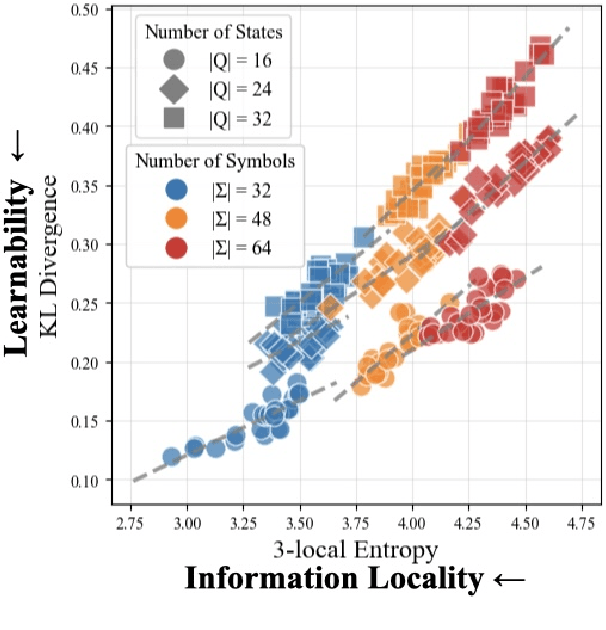

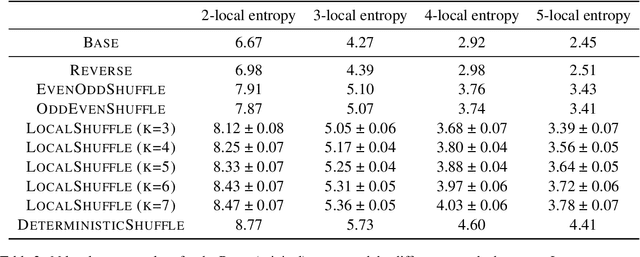
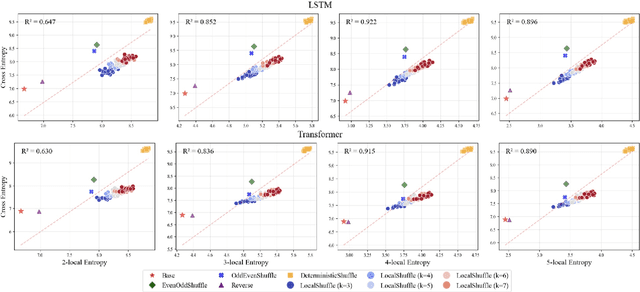
Abstract:Inductive biases are inherent in every machine learning system, shaping how models generalize from finite data. In the case of neural language models (LMs), debates persist as to whether these biases align with or diverge from human processing constraints. To address this issue, we propose a quantitative framework that allows for controlled investigations into the nature of these biases. Within our framework, we introduce $m$-local entropy$\unicode{x2013}$an information-theoretic measure derived from average lossy-context surprisal$\unicode{x2013}$that captures the local uncertainty of a language by quantifying how effectively the $m-1$ preceding symbols disambiguate the next symbol. In experiments on both perturbed natural language corpora and languages defined by probabilistic finite-state automata (PFSAs), we show that languages with higher $m$-local entropy are more difficult for Transformer and LSTM LMs to learn. These results suggest that neural LMs, much like humans, are highly sensitive to the local statistical structure of a language.
The Harmonic Structure of Information Contours
Jun 04, 2025

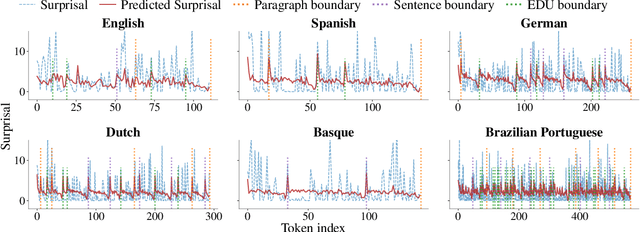
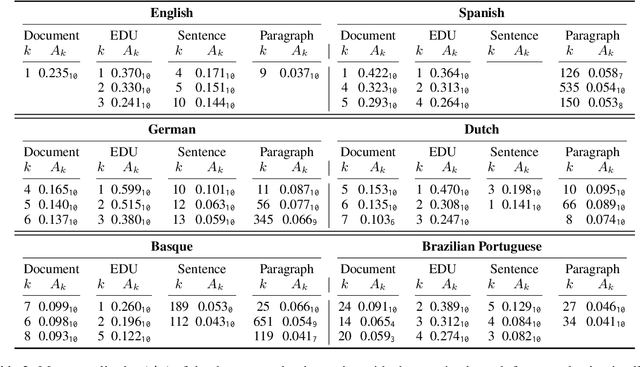
Abstract:The uniform information density (UID) hypothesis proposes that speakers aim to distribute information evenly throughout a text, balancing production effort and listener comprehension difficulty. However, language typically does not maintain a strictly uniform information rate; instead, it fluctuates around a global average. These fluctuations are often explained by factors such as syntactic constraints, stylistic choices, or audience design. In this work, we explore an alternative perspective: that these fluctuations may be influenced by an implicit linguistic pressure towards periodicity, where the information rate oscillates at regular intervals, potentially across multiple frequencies simultaneously. We apply harmonic regression and introduce a novel extension called time scaling to detect and test for such periodicity in information contours. Analyzing texts in English, Spanish, German, Dutch, Basque, and Brazilian Portuguese, we find consistent evidence of periodic patterns in information rate. Many dominant frequencies align with discourse structure, suggesting these oscillations reflect meaningful linguistic organization. Beyond highlighting the connection between information rate and discourse structure, our approach offers a general framework for uncovering structural pressures at various levels of linguistic granularity.
Playpen: An Environment for Exploring Learning Through Conversational Interaction
Apr 11, 2025Abstract:Are we running out of learning signal? Predicting the next word in an existing text has turned out to be a powerful signal, at least at scale. But there are signs that we are running out of this resource. In recent months, interaction between learner and feedback-giver has come into focus, both for "alignment" (with a reward model judging the quality of instruction following attempts) and for improving "reasoning" (process- and outcome-based verifiers judging reasoning steps). In this paper, we explore to what extent synthetic interaction in what we call Dialogue Games -- goal-directed and rule-governed activities driven predominantly by verbal actions -- can provide a learning signal, and how this signal can be used. We introduce an environment for producing such interaction data (with the help of a Large Language Model as counterpart to the learner model), both offline and online. We investigate the effects of supervised fine-tuning on this data, as well as reinforcement learning setups such as DPO, and GRPO; showing that all of these approaches achieve some improvements in in-domain games, but only GRPO demonstrates the ability to generalise to out-of-domain games as well as retain competitive performance in reference-based tasks. We release the framework and the baseline training setups in the hope that this can foster research in this promising new direction.
Triangulating LLM Progress through Benchmarks, Games, and Cognitive Tests
Feb 20, 2025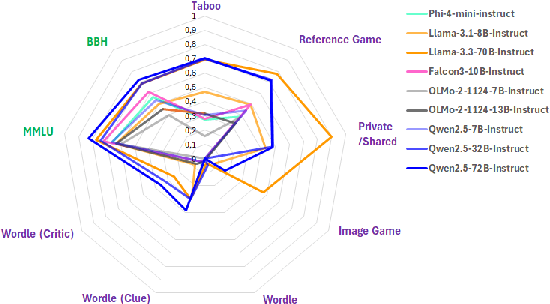
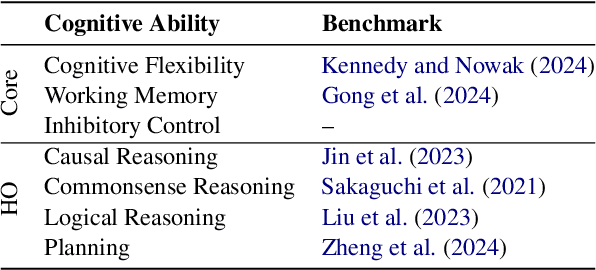
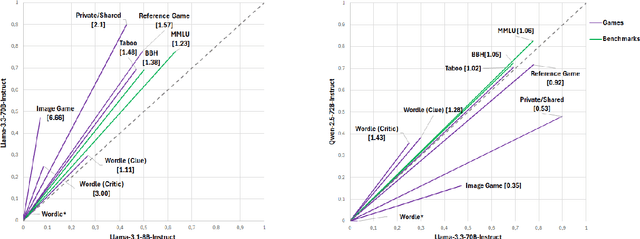
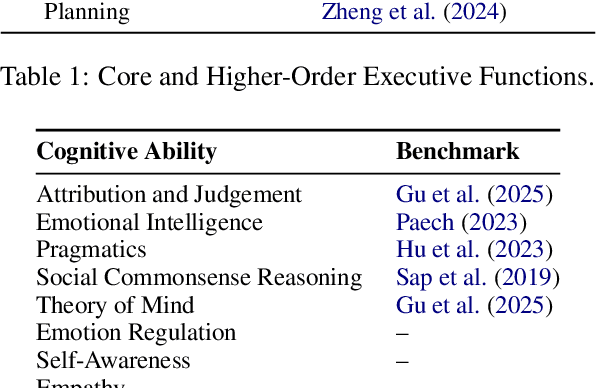
Abstract:We examine three evaluation paradigms: large question-answering benchmarks (e.g., MMLU and BBH), interactive games (e.g., Signalling Games or Taboo), and cognitive tests (e.g., for working memory or theory of mind). First, we investigate which of the former two-benchmarks or games-is most effective at discriminating LLMs of varying quality. Then, inspired by human cognitive assessments, we compile a suite of targeted tests that measure cognitive abilities deemed essential for effective language use, and we investigate their correlation with model performance in benchmarks and games. Our analyses reveal that interactive games are superior to standard benchmarks in discriminating models. Causal and logical reasoning correlate with both static and interactive tests, while differences emerge regarding core executive functions and social/emotional skills, which correlate more with games. We advocate the development of new interactive benchmarks and targeted cognitive tasks inspired by assessing human abilities but designed specifically for LLMs.
From Language Models over Tokens to Language Models over Characters
Dec 04, 2024Abstract:Modern language models are internally -- and mathematically -- distributions over token strings rather than \emph{character} strings, posing numerous challenges for programmers building user applications on top of them. For example, if a prompt is specified as a character string, it must be tokenized before passing it to the token-level language model. Thus, the tokenizer and consequent analyses are very sensitive to the specification of the prompt (e.g., if the prompt ends with a space or not). This paper presents algorithms for converting token-level language models to character-level ones. We present both exact and approximate algorithms. In the empirical portion of the paper, we benchmark the practical runtime and approximation quality. We find that -- even with a small computation budget -- our method is able to accurately approximate the character-level distribution (less than 0.00021 excess bits / character) at reasonably fast speeds (46.3 characters / second) on the Llama 3.1 8B language model.
Towards a Similarity-adjusted Surprisal Theory
Oct 23, 2024



Abstract:Surprisal theory posits that the cognitive effort required to comprehend a word is determined by its contextual predictability, quantified as surprisal. Traditionally, surprisal theory treats words as distinct entities, overlooking any potential similarity between them. Giulianelli et al. (2023) address this limitation by introducing information value, a measure of predictability designed to account for similarities between communicative units. Our work leverages Ricotta and Szeidl's (2006) diversity index to extend surprisal into a metric that we term similarity-adjusted surprisal, exposing a mathematical relationship between surprisal and information value. Similarity-adjusted surprisal aligns with information value when considering graded similarities and reduces to standard surprisal when words are treated as distinct. Experimental results with reading time data indicate that similarity-adjusted surprisal adds predictive power beyond standard surprisal for certain datasets, suggesting it serves as a complementary measure of comprehension effort.
Surprise! Uniform Information Density Isn't the Whole Story: Predicting Surprisal Contours in Long-form Discourse
Oct 21, 2024



Abstract:The Uniform Information Density (UID) hypothesis posits that speakers tend to distribute information evenly across linguistic units to achieve efficient communication. Of course, information rate in texts and discourses is not perfectly uniform. While these fluctuations can be viewed as theoretically uninteresting noise on top of a uniform target, another explanation is that UID is not the only functional pressure regulating information content in a language. Speakers may also seek to maintain interest, adhere to writing conventions, and build compelling arguments. In this paper, we propose one such functional pressure; namely that speakers modulate information rate based on location within a hierarchically-structured model of discourse. We term this the Structured Context Hypothesis and test it by predicting the surprisal contours of naturally occurring discourses extracted from large language models using predictors derived from discourse structure. We find that hierarchical predictors are significant predictors of a discourse's information contour and that deeply nested hierarchical predictors are more predictive than shallow ones. This work takes an initial step beyond UID to propose testable hypotheses for why the information rate fluctuates in predictable ways
 Add to Chrome
Add to Chrome Add to Firefox
Add to Firefox Add to Edge
Add to Edge